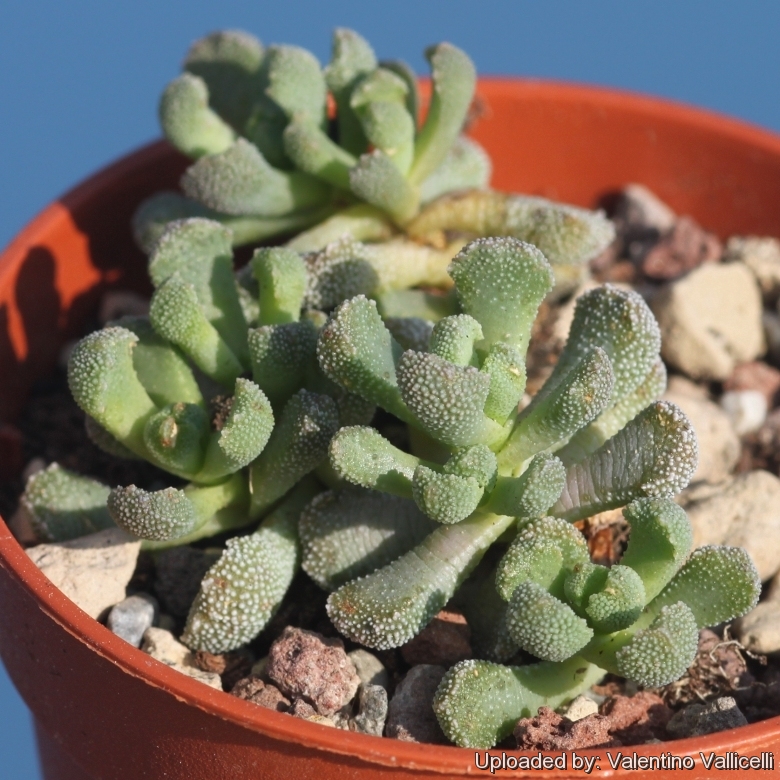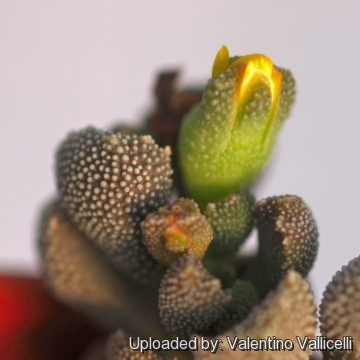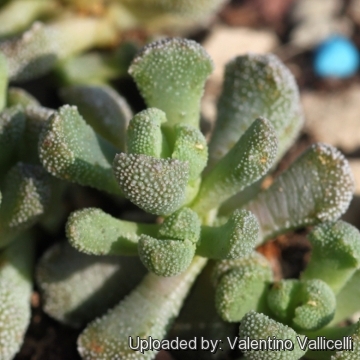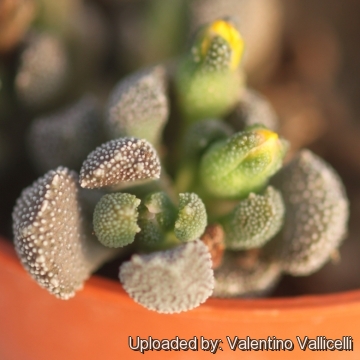




Your support is critical to our success.
Notes Mesembryanthemum [H.M.L. Bolus] 3: 14. 1936 [5 Feb 1936]
Family: AIZOACEAE

Origin and Habitat: South Africa (Cape Province)
Synonyms:
- Rhinephyllum broomii L. Bolus
Description: Rhinephyllum broomiiSN|31844]]SN|31844]] is a very small, compact, clumping succulent, 1-3 cm high (including flowers) perennials or quasi-annuals, the earlier in the year they are planted, the better the chances for winter survival.
Root: Fleshy.
Stem: Shortened with internodes hidden by the leaves.
Leaves: 1-2,5 cm long, spathulate or spoon-shaped, with a flat top surface and a convex bottom, the top tightly tuberculate, with 2-4(5) pairs of marginal teeth, indistinctly keeled towards the tip, olive green, to 1 cm x 7 mm.
Flower: Crepuscular (blooming at twilight), stalks to 5 mm. Flowers 10-12 mm in diameter, petals yellow or yellow-white. It is often monocarpic, but does produce an abundance of seed
Blooming seson: The flowers are produced in spring and summer over a long season. Rhinephyllum broomiiSN|31844]]SN|31844]] can be brought to flower in 100 days from seed.
Fruit: Rhinephyllum broomiiSN|31844]]SN|31844]] is self-fertile and its fruits should be regularly plucked.
Bibliography: Major references and further lectures
1) Heidrun E. K. Hartmann “Aizoaceae F – Z” Springer, 2002
2) Jacobsen. “Handbook of succulent plants” 1328 (1960)
3) James Cullen, Sabina G. Knees, H. Suzanne Cubey “The European Garden Flora Flowering Plants: A Manual for the Identification of Plants Cultivated in Europe, Both Out-of-Doors and Under Glass - Casuarinaceae to Aristolochiaceae” Cambridge University Press, 11/ago/2011
4) Riha & Subik “The illustrated encyclopaedia of cacti and other succulents” (1981)
5) E. K. Hartmann “The Illustrated Handbook of Succulent Plants” 2001

Rhinephyllum broomii Photo by: Valentino Vallicelli

Rhinephyllum broomii Photo by: Valentino Vallicelli

Rhinephyllum broomii Photo by: Valentino Vallicelli

Rhinephyllum broomii Photo by: Valentino Vallicelli
Cultivation and Propagation: Rhinephyllum broomii is a "summer grower" which is most active from early spring and heading for winer dormancy, but in favourable growing conditions it keeps going over the winter too and doesn't need particular care. Rhinephyllum seems to prefer a fairly dry rest in winter but flowers profusely whenever watered. It is the good choice for anyone wanting to start growing succulents. It is quite hardy and can take a light frost and in very dry warm-temperate regions these succulents make very impressive out door ground covers.
Growing rate: It is vigorous and quick-growing, speedily forming lateral shoots and low mats.
Soil: It needs a well-drained soil mix, but can tolerate a wide variety of soil types and growing locations. Requires good drainage as it it is prone to root rot. It can grows outdoor in sunny, dry, rock crevices (protection against winter wet is required) It can also be cultivated in alpine house, in poor, drained soil.
Fertilization: Feed it once during the growing season with a fertilizer specifically formulated for cactus and succulents (poor in nitrogen), including all micro nutrients and trace elements diluted to ½ the strength recommended on the label. It thrives in poor soils and need a limited supplies of fertilizer to avoid the plants developing excess vegetation, which is easily attacked by fungal diseases.
Watering: They are not at all delicate and can take some water year-round and will tolerate some over watering, but the challenge is to help them keep their compact form and prevent elongation of the stem. Water minimally in winter, only when the plant starts shrivelling, water more abundantly when they are growing in the spring and summer, but let the soil dry between soaking. An occasional summer soaking is wise. If grown in a container, bottom watering by immersing the container is recommended. They must have very dry atmosphere.
Light: It needs a bright sunny or light shade exposure in winter, but keep cool and partially shaded in summer.
Hardiness: It prefer a very bright situation and require a minimum temperature 0°C (But will take frost and is hardy down to -23° C for short periods if it is in dry soil ). USDA zones 8 – 11. The earlier in the year they are planted, the better the chances for winter survival. True with many of the Mesembryanthemaceae. As house plants they tend to grow in fair weather and rest when temperatures are too hot or too cool.
Uses: Container, rock garden.
Pests & diseases: Rhinephyllum may be attractive to a variety of insects, but plants in good condition should be nearly pest-free, particularly if they are grown in a mineral potting-mix, with good exposure and ventilation. Nonetheless, there are several pests to watch for:
- Red spiders: they may be effectively rubbed up by misting the vulnerable plants every day. - Mealy bugs: occasianlly they develop aerial into the new leaves and flowers with disfiguring results, but the worst types develop underground on the roots and are invisible except by their effects.
- Sciara Flies: they are one of the major problems for seedlings. It is a good practice to mulch your seedlings with a layer of grit, which will strongly discourage the flies.
- Scales, thrips and aphids: (they are rarely a problem.)
It is wise to treat your whole collection with a systemic insecticide twice a year in spring and autumn.
- Rot: it is only a minor problem with mesembs if the plants are watered and “aired” correctly. If they are not, fungicides won't help all that much.
Propagation: It is very easy to start from seed or cuttings. Seeds germinate in 7-14 days at 21°C in spring. To make a cutting twist off a branch with at least a part of roots and permit it to dry out a couple of days, lay it on the soil and insert the stem end partially into the soil. Try to keep the cutting somewhat upright so that the roots are able to grow downward.
| Your Actions | |
|---|---|
| Back to Rhinephyllum index | |
| Back to Aizoaceae index | |
 |
Back to Succulents Encyclopedia index |
Privacy stantement - Terms and conditions - How to cite - About us - Feedback - Donate



